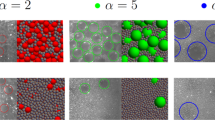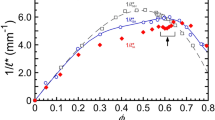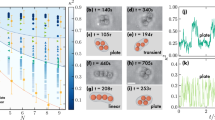Abstract
Packing problems are ubiquitous1,2, ranging from oil extraction through porous rocks to grain storage in silos and the compaction of pharmaceutical powders into tablets. At a given density, particulate systems pack into a mechanically stable and amorphous jammed state3,4. Previous theoretical studies have explored a connection between this jammed state and the glass transition4,5,6,7,8, the thermodynamics of jamming9,10,11,12 and geometric modelling of random packings13,14,15. Nevertheless, a simple underlying mechanism for the random assembly of athermal particles, analogous to crystalline ordering, remains unknown. Here we use three-dimensional measurements of packings of polydisperse emulsion droplets to build a simple statistical model in which the complexity of the global packing is distilled into a local stochastic process. From the perspective of a single particle, the packing problem is reduced to the random formation of nearest neighbours, followed by a choice of contacts among them. The two key parameters in the model—the available space around a particle and the ratio of contacts to neighbours—are directly obtained from experiments. We demonstrate that this ‘granocentric’ view captures the properties of the polydisperse emulsion packing—ranging from the microscopic distributions of nearest neighbours and contacts, to local density fluctuations, to the global packing density. Application of our results to monodisperse and bidisperse systems produces quantitative agreement with previously measured trends in global density16. Our model therefore reveals a general principle of organization for random packing and may provide the foundations for a theory of jammed matter.
This is a preview of subscription content, access via your institution
Access options
Subscribe to this journal
Receive 51 print issues and online access
$199.00 per year
only $3.90 per issue
Buy this article
- Purchase on Springer Link
- Instant access to full article PDF
Prices may be subject to local taxes which are calculated during checkout



Similar content being viewed by others
References
Jaeger, H. M., Nagel, S. R. & Behringer, R. P. Granular solids, liquids, and gases. Rev. Mod. Phys. 68, 1259–1273 (1996)
de Gennes, P. G. Granular matter: a tentative view. Rev. Mod. Phys. 71, S374–S382 (1999)
Cates, M. E., Wittmer, J. P., Bouchaud, J.-P. & Claudin, P. Jamming, force chains, and fragile matter. Phys. Rev. Lett. 81, 1841–1844 (1998)
Liu, A. J. & Nagel, S. R. Nonlinear dynamics: jamming is not just cool anymore. Nature 396, 21–22 (1998)
Barrat, A., Kurchan, J., Loreto, V. & Sellitto, M. Edwards' measures for powders and glasses. Phys. Rev. Lett. 85, 5034–5037 (2000)
Coniglio, A., Fierro, A., Herrmann, H. J. & Nicodemi, M. Unifying Concepts in Granular Media and Glasses: From the Statistical Mechanics of Granular Media to the Theory of Jamming (Elsevier Science, 2004)
Corwin, E. I., Jaeger, H. M. & Nagel, S. R. Structural signature of jamming in granular media. Nature 435, 1075–1078 (2005)
Parisi, G. & Zamponi, F. Mean field theory of the glass transition and jamming of hard spheres. Preprint at 〈http://arXiv.org/abs/0802.2180〉 (2008)
Edwards, S. & Oakeshott, R. Theory of powders. Physica A 157, 1080–1090 (1989)
Lechenault, F., da Cruz, F., Dauchot, O. & Bertin, E. Free volume distributions and compactivity measurement in bidimensional granular packing. J. Stat. Mech. Theory Exp. P07009 (2006)
Aste, T. Volume fluctuations and geometrical constraints in granular packs. Phys. Rev. Lett. 96, 018002 (2006)
Song, C., Wang, P. & Makse, H. A. A phase diagram for jammed matter. Nature 453, 629–632 (2008)
Gotoh, K. & Finney, J. Statistical geometrical approach to random packing density of equal spheres. Nature 252, 202–205 (1974)
Dodds, J. Simplest statistical geometric model of simplest version of multicomponent random packing problem. Nature 256, 187–189 (1975)
Dodds, J. The porosity and contact points in multicomponent random sphere packings calculated by a simple statistical geometric model. J. Colloid. Interface Sci. 77, 317–327 (1980)
Yerazunis, S., Cornell, S. & Wintner, B. Dense random packing of binary mixtures of spheres. Nature 207, 835–837 (1965)
Liu, C. H. et al. Force fluctuations in bead packs. Science 269, 513–515 (1995)
Brujić, J. et al. 3d bulk measurements of the force distribution in a compressed emulsion system. Faraday Discuss. 123, 207–220 (2003)
Majmudar, T. & Behringer, R. Contact force measurements and stress-induced anisotropy in granular materials. Nature 435, 1079–1082 (2005)
Zhou, J., Long, S., Wang, Q. & Dinsmore, A. Measurement of forces inside a three-dimensional pile of frictionless droplets. Science 312, 1631–1633 (2006)
Bernal, J. Geometrical approach to the structure of liquids. Nature 183, 141–147 (1959)
Brujić, J. et al. Measuring the coordination number and entropy of a 3d jammed emulsion packing by confocal microscopy. Phys. Rev. Lett. 98, 248001 (2007)
Donev, A. et al. Improving the density of jammed disordered packing using ellipsoids. Science 303, 990–993 (2004)
Torquato, S., Truskett, T. M. & Debenedetti, P. G. Is random close packing of spheres well defined? Phys. Rev. Lett. 84, 2064–2067 (2000)
Richard, P., Oger, L. & Troadec, J.-P. A model of binary assemblies of spheres. Eur. Phys. J. E 6, 295–303 (2001)
Finney, J. Random packings and structure of simple liquids. Proc. R. Soc. Lond. A 319, 479–493 (1970)
Alexander, S. Amorphous solids: their structure, lattice dynamics and elasticity. Phys. Rep. 296, 65–236 (1998)
Kamien, R. & Liu, A. Why is random close packing reproducible? Phys. Rev. Lett. 99, 155501 (2007)
Aste, T., Saadaftar, M. & Senden, T. Local and global relations between the number of contacts and density in monodisperse sphere packs. J. Stat. Mech. Theory Exp. P07010 (2006)
Schmitt, V., Leal-Calderon, F. & Bibette, J. in Topics in Current Chemistry Vol. 227, Colloid Chemistry II (ed. Antonietti, M.) 195–215 (Springer, 2003)
Acknowledgements
We thank G. Ben Arous, S. T. Bramwell, P. M. Chaikin, I. Z. Corwin, J.-B. Gouéré, P. C. W. Holdsworth, D. Levine, D. J. Pine and J. R. Royer for discussions and comments. J.B. holds a Career Award at the Scientific Interface from the Burroughs Wellcome Fund. This work was partially supported by NYU MRSEC Award DMR:0820341.
Author Contributions M.C. and E.I.C. contributed equally to this Letter and are listed in alphabetical order.
Author information
Authors and Affiliations
Corresponding author
Supplementary information
Supplementary Information
This file contains Supplementary Data and Supplementary Figures A-H and Supplementary Figure 1 with Legends. (PDF 1262 kb)
Rights and permissions
About this article
Cite this article
Clusel, M., Corwin, E., Siemens, A. et al. A ‘granocentric’ model for random packing of jammed emulsions. Nature 460, 611–615 (2009). https://doi.org/10.1038/nature08158
Received:
Accepted:
Issue Date:
DOI: https://doi.org/10.1038/nature08158
This article is cited by
-
Chromatic neuronal jamming in a primitive brain
Nature Physics (2020)
-
Contact forces distribution for a granular material from a Monte Carlo study on a single grain
Granular Matter (2018)
-
Dynamic Simulation of Random Packing of Polydispersive Fine Particles
Brazilian Journal of Physics (2018)
-
Local structure controls the nonaffine shear and bulk moduli of disordered solids
Scientific Reports (2016)
-
A Geometric-Structure Theory for Maximally Random Jammed Packings
Scientific Reports (2015)
Comments
By submitting a comment you agree to abide by our Terms and Community Guidelines. If you find something abusive or that does not comply with our terms or guidelines please flag it as inappropriate.



